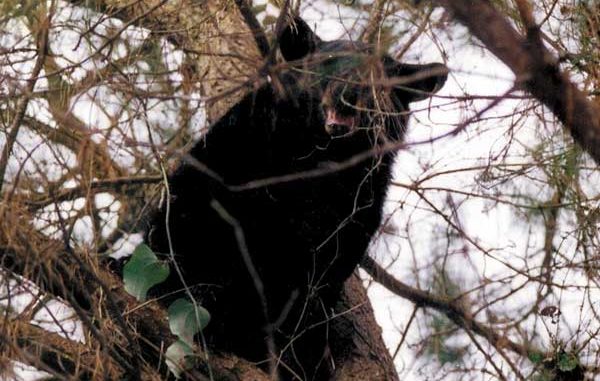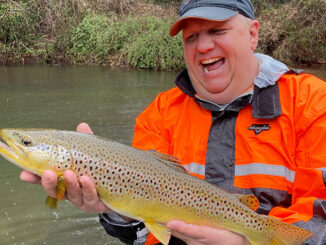
The Tradition combines with modern technology for WNC’s bear hunters.
The tradition extends back in time to when settlers first came to North Carolina’s western mountains.
Today those traditions survive in the names of hollows and creeks in the Blue Ridge; dog breeds such as Plotts, Walkers and Blueticks; and hunters standing near an early morning fire to ward off the chill.
Times have changed the purposes of the ancient mountain rituals from subsistence hunting or taking down a marauding predatory animal that threatens livestock. Today men indulge in bear hunting for the sheer fun of it and to honor the past.
Modern transportation has caught up to and surpassed horses, mules and wagons once used for carrying hunters and dogs. And houndsmen keep track of their valuable trackers through the greatest of technological advances, tracking collars, instead of cupping hands at ears and straining to hear a distant hound’s bawl.
No matter the changes, the tradition of fall bear hunting in the western N.C. mountains continues to survive.
Although bear hunting in the mountains is tradition-based, it’s also an important management tool for the N.C. Wildlife Resources Commission. With burgeoning bear and human populations, hunting provides a way of controlling the interaction between bears and humans (see sidebar).
According to District 9 WRC biologist Mike Carraway, the latest population estimate for the mountain region is 4,000 to 5,000 bears, but that may be on the low end. It
wasn’t always that high.
In the 1970s bears were at a low ebb. That trend reversed when bear sanctuaries were established at game lands throughout the mountains.
“What is primarily responsible for our increase in the bear population since the 1970s is bear sanctuaries,” Carraway said. “Without hunting at those sanctuaries, as the bear population increased and reached its maximum capacity, bears started to disperse to outlying areas.”
Local hunters appreciate the effort of the WRC in order to preserve their October traditions.
What are the characteristics of a modern N.C. mountain bear hunt? Local resident and long-time bear hunter Eddie Frizsell provided the answer.
“A bear hunt in the mountains can last from several hours to several days, depending on many factors,” he said.
The rugged terrain is one of the main obstacles. Frizsell knows because he hunts bears in the mountains and at the eastern coast.
Because of expanding residential developments, much of today’s bear hunting occurs at the large areas of the Pisgah and Nantahala National Forests that together cover more than 1 million acres.
According to Frizsell, hunts start early in the morning.
“We usually get together around 3 or 4 a.m. for breakfast the day of the hunt,” he said. “There can be anywhere from four to 40 people on the hunt.
“After that, we go out with our dogs to assigned areas where we’ve seen sign before or to look for fresh tracks.”
Once a fresh track is found the hunters unleash a “strike dog.” Strike dogs are the cream of the crop among bear dogs, with great noses and experience for determining the length of time between the scenting of a track and when it actually was created by a black bear.
If the hunter finding a bear track doesn’t have a strike dog with him, he’ll use a CB radio to call another hunter with such a hound.
When a strike dog starts baying, or “opens“ on a track, it’s considered fresh enough to pursue. If the track isn’t particularly fresh, hunters may allow the strike dog to start trailing in hopes the scent becomes hot.
“If (the dog) screams every breath, we know the bear just crossed (the road), and we’ll bring in a pack (of hounds),” Frizsell said.
A hound’s owner can determine by listening to his dog’s voice how hot the trail may or may not be. Strike dogs are highly valued among the bear-hunting fraternity and, in many instances, are worth thousands of dollars.
Standers at ridge lines are also listening for a strike dog to pick up the cadence. Once it’s confirmed the strike dog is on a hot scent, a pack of six to 12 dogs will be brought close to the strike dog where they can hear him. These hounds are set free one or two at a time to join the chase.
As well trained and conditioned as these dogs are, that’s just the beginning of a bad day for the bear.
If you talk to mountain bear men, the hunt is entirely about the dogs. One breed of dog stands out among the many types of bear chasers in the mountains — the Plott hound.
The Plott is the sentimental favorite among mountain bear hunters for several reasons. First, the breed’s origins track back to the 1750s when George Plott, a German immigrant, settled in the mountains and started breeding these dogs to hunt bears. The Plott’s popularity also comes into play; it’s the official state dog of North Carolina.
The second most-popular breed is the Walker, followed by blue ticks and black and tans.
Once the dogs are on a hot trail, another modern convenience comes into play, tracking collars. These aren’t shock collars used to train dogs but are for following the movements of hounds across the rugged mountain terrain.
As valuable as these dogs are, the collars not only are useful for keeping up with hounds on a hot trail, but they’re valuable in finding a dog that has separated from the pack.
Frizsell said the tracking collar is one of the greatest improvements in bear hunting. Previously, it wasn’t uncommon to search for dogs days and weeks after a hunt. Although it’s against N.C. law to remove a tracking collar from a dog, that’s become an increasing problem.
Frizsell said he thinks most people, who might encounter a lost hound, just don’t understand the device’s importance and perhaps believe they harm the dog. If they remove a collar, the owner is the one who’s lost his hopes of finding his hound — or he may follow the electronic signal to somebody’s house, where confrontations may occur.
Once a pack of bear hounds is on a hot trail, the hard work begins. As much as possible, hunters follow the sounds of the pack and tracking-collar signals by riding vehicles on roads. That’s not always easy in bear habitat, especially at public lands.
According to Carraway, the diets of bears when the hunting season starts in October is primarily acorns and grapes as they fatten up to go into hibernation. And the vast hardwood forests of nearly 1 million acres of national forest, where much of that food is found, is inhospitable for humans and has few roads for hunters to follow in their trucks.
The mountains also can be treacherous. However, he estimates about 70 percent of bears the dogs trail are finally treed. Occasionally a wily old boar will give the dogs the slip.
Many times a bear will climb a rock ledge where the dogs can’t follow. And,sometimes a bear gets so deep into the national forests that hunters can’t keep up on foot.
Frizsell said the mountains, valleys and hollows in the deep forest also can play tricks with the sounds of baying dogs. Sometimes hunters can be within a few hundred yards of a pack of hounds and not be able to tell which direction they’re heading.
That’s where tracking collars and knowledge of terrain comes into play. Hunters in vehicles will circumnavigate the area, sometimes driving up to 60 miles, to get in front of a moving bear. After all that effort, sometimes it’s been hours since the chase began and the dogs have either lost the bear or, if they’ve treed the bruin, their voices have given out, and tracking collars are the only hope to find them.
Some dogs never give up, which makes them extremely valuable.
“There are famous dogs that will ‘sleep’ with a bear,” Frizsell said. “If the bear is treed and no hunters arrive, the dog will sleep at the bottom of the tree. If the bear climbs down, the dog will follow, stopping when the bear does. Some of these dogs have been known to stay with a bear for days.”
Those kinds of bear dogs are sold by their owners about as often as they sell their own children.
Typically, a bear will be treed by the pack. Hunters can determine when a bear climbs a tree because a dog’s voice changes as it raises its head to bay toward the sky.
Once the hunters arrive at a tree with a bear in its branches, they’ll make a decision about whether or not to shoot the animal. The first thing they try to do is determine is a bear’s gender. Hunters don’t want to kill sows (females) that may have yearlings in the area or young male bears following them.
Frizsell said occasionally a bear will “bay up“ in a laurel thicket on the side of a ridge or mountain instead of going up a tree.
“If it’s bayed up, it’s usually a big bear and is harvestable,” he said.
Bayed bears are usually males, too large to climb trees.
“If he’s willing to fight the dogs, it’s probably an old boar that’s big,” he said.
Changes in private land ownership and development have impacted traditional mountain bear hunts, mostly restricting where and how hunters can release their hounds. But bear hunters, like the animals they cherish and pursue, adapt while holding on to long-held traditions. It’s part of who they are.
As long as people and bears inhabit western N.C., October will bring the smell of an early morning hunting fire and the sound of Plott hounds on a trail.
After all, it’s a mountain tradition.




Be the first to comment